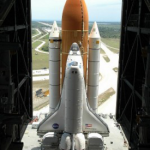
Asni’s Art Blog: Space Shuttle
Having a permanent space station in orbit is all well and fine, but how to get people and materials on and off it?

Having a permanent space station in orbit is all well and fine, but how to get people and materials on and off it?

Not just scuba divers, but spacewalking astronauts could also experience decompression sickness. i.e. “the bends”

Shuttle Astronaut Mike Mullane has some thoughts about the IBM team who built the Shuttle onboard flight software.

The people who designed, tested and supported the Space Shuttle Flight Software were the most exceptional technical team I’ve encountered.

Space Shuttle is ended. The future of near-earth manned spaceflight is now in the hands of private industry. As I believe it should be.

Was Space Shuttle worth it? The International Space Station. The Hubble Space Telescope. How do you set a value on something that humans had only dreamed about?

As with Apollo 13, NASA “can do amazing things when they’ve got their back against the wall”. But for Space Shuttle Columbia they didn’t try.

Richard Feynman’s question about Space Shuttle Challenger was, “What is the cause of management’s fantastic faith in the machinery?”

On the eve of the Space Shuttle Challenger launch the Morton Thiokol engineering team protested the decision to launch. They were overridden by NASA

Space Shuttle Discovery’s flight in 1984 dumped an unexpected “payload” in orbit.

After Space Shuttle Discovery recovered from a dangerous launch abort in June 1984, the second try was flawless and spectacular.

The maiden voyage of Space Shuttle Discovery was scheduled for June 25, 1984. The first-ever main engine shutdown launch abort scared the crap out of us.

Mike Mullane offered me a personal memento from Judy from their first Space Shuttle flight. I still have it.

Our Shuttle flight software team had the “distinction” of hearing Walter Cronkite describe, live and on national television, whether we’d done our work correctly.

I had visions of the Space Shuttle Enterprise getting jostled during separation and colliding with the 747’s vertical stabilizer – which would definitely make for a bad day all around.

NASA’s John Aaron set high standards for IBM, and Space Shuttle onboard software came closer to “error-free” than any large, complex software ever built.

I met with John Aaron to explain why IBM couldn’t fulfill a Shuttle software contract that required zero errors. His answer changed my mind.

NASA required IBM’s Space Shuttle software to be delivered “error-free”. It doesn’t take a rocket scientist to understand the likelihood of that was extremely low.

During the Apollo Program, NASA’s Phil Shaffer had subjected me to what I’d describe today as a version of “Shark Tank”. I wasn’t looking forward to presenting to him again on Shuttle.

The first version of the Shuttle flight software had two serious problems: it couldn’t fit in the computer, and it ran way too slow. IBM was two years into the contract and basically nothing worked. All hell broke loose.

During high speed atmospheric flight, the extreme forces buffeting the Space Shuttle produced abrupt, violent oscillations that, left unattended, would cause it to spiral out of control. No human was capable of flying the Shuttle unassisted.

The Space Shuttle’s onboard computer system alone weighed more than the entire Apollo Command Module.

An Air Force requirement demanded wings for the Space Shuttle, and that drove everything else about its design. Yet they were never used for that purpose.

In spite of having four separate sets of rocket engines, for the entire flight through the atmosphere and landing, the Shuttle Orbiter was simply an unpowered glider.

In 1959, U.S. astronauts piloted an airplane-shaped rocket ship into space, and then flew nearly 200 missions, twenty years before the first Space Shuttle ever left the ground.

Now that the era of Space Shuttle has passed, was it all worth it? While the Apollo Program was the great adventure of our age, what exactly did this stepchild do to earn its keep?

Kevin R. Grazier is a planetary scientist and friend of mine who has regularly landed gigs as a science consultant on a number of popular Hollywood movies and TV shows. Including GRAVITY.

The space art of Marilynn Flynn – one of the few earth-based artists to have her work flown in space.

I was watching the TV commercial featuring the Space Shuttle Endeavor the other night – you know, the one where a truck tows the Shuttle through the streets of Los Angeles to its permanent exhibit […]
Notifications

Recent Comments